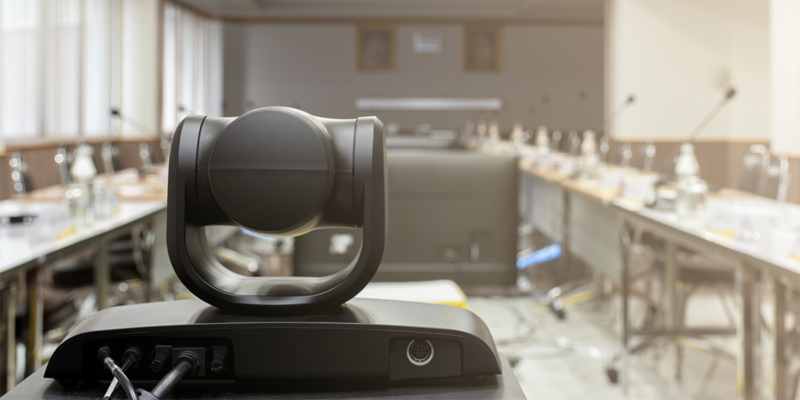Part 1: What I Learned About the Industry by (Not Attending ISE or InfoComm, But) Watching 2,000 Product Videos

Part 1: UCC and Display Technologies
I didn’t go to ISE in Barcelona this year, or InfoComm in Las Vegas just a few weeks later, but as the editor in charge of video titling for rAVe [PUBS] for both, I did watch pretty much every video the team shot from both show floors, which was about 2,000 videos. Although certainly not as fun as attending in person, it’s a pretty efficient way to digest an enormous amount of technology as shown and marketed on a trade show floor, and it’s given me a unique insight into what the industry is doing, collectively — particularly since the shows were only a few weeks apart this year. There was a lot of overlap, but not so much that it felt like they were the same show. Here are the things that I noticed.
UCC
No surprise to anyone, the pandemic had a huge impact on the direction of technology in the AV industry, so much so that I’d estimate close to half of the products on both show floors were related to UCC, videoconferencing, remote collaboration and hybrid/HyFlex teaching solutions.
In-home UCC and all-in-one solutions
For the first time at what are mostly commercial-AV shows, I saw a lot of products intended for “consumers,” to be used in people’s homes, in particular, home videoconferencing and collaboration solutions for remote workers. I put “consumers” in quotes because while they are intended for use by an end user who’s typically at home, the devices were really designed to be an extension of a bigger enterprise solution, whether that’s a network of UCC devices in a lot of non-primary-office locations or a hub-and-spoke design with products that extend UCC installs at corporate or university campuses. Typically these are designed around the idea of meeting equity, i.e., a system in which remote participants are equally capable of participation, collaboration and even leading meetings as someone in a traditional office. This meant a lot of high-quality mics, headphones, cameras and other widgets designed for home offices.
I saw video/audio combination sound bars, previously a solution for small meeting rooms and huddle spaces, for home offices, as well as numerous all-in-one solutions in which a camera, mic, speakers, and a PC, sometimes with proprietary software (or often, Android) along with a display, so users could keep meetings separate from their computer. Here are some examples:
Newline’s FLEX All-in-One Desktop Collaboration Device
Dell’s 32” Videoconferencing Monitor With 4K Webcam
Neat’s Neat Frame, a personal video device and touch display
Poly’s Poly Studio P21 personal meeting display with ambient lighting
DTEN’s all-in-one solutions
Professional, remote broadcasting
At InfoComm in particular, numerous solutions were shown that would enable professional presentations, classes or broadcasts from a home office. Some of them were basically mini-broadcast studios, and even included teleprompting (hardware- or software-based). There were also a few kits designed for social media creators that want the highest-end options on the market, particularly for those like the ones on Twitch that do a lot of live broadcasting. The proliferation of remote work, as well as the number of people who want to create professional content, has really blended the once-clear lines between videoconferencing, broadcast and technology-enabled presentations and teaching.
Interoperability and the emergence of dominant software platforms
One particularly interesting thing was while there was a significant focus on interoperability between different meeting types, they nearly all focused on three choices: Microsoft Teams, Zoom and Google Meet (mainly the first two, but Google dominates education and as the best free option, will never really go away). I think I heard Webex mentioned, but only once or twice. This makes a lot of sense: While most of us have been using or testing various UCC platforms for years, much of the rest of the world was forced to rapidly adopt these technologies, often at home without the support of busy IT departments. UCC and videoconferencing software inherently has an interoperability problem, because you have to interact with at least one other person and their choice (or organization’s choice) of hardware and software. No one wants to download and install — let alone figure out — more than a couple of solutions.
Microsoft Teams has become the enterprise solution of choice, Google Meet is free and widely used by schools and universities, and Zoom, say what you will about its many imperfections, was what everyone else learned. The amount of engineering that went into both hardware and the number of software solutions to simplify the interoperability of these three platforms was enormous. It’s hard for me to see a market for other software solutions, aside from perhaps government/military or court systems.
21:9, speaker framing and the influence of Microsoft
UCC has become such an important AV vertical that a new aspect ratio has emerged as a standard to facilitate certain set-ups — 21:9. This is driven primarily by Microsoft Teams’ new front-row view, in which each participant is framed within their own screen in a multiview format. Although the view is flexible and can allow each frame to be displayed in a few different ways, a preferred format has turned out to be displaying each person side-by-side at the bottom of a display, with room for collaborative content or slide deck, and a chat window above. 21:9 displays, often with a 2560×1080 resolution, are becoming the standard for this view, and display manufacturers are leaning in. Jupiter has gone all in, with a new line of 21:9 flat panel displays, and a partnership with Re Mago for Valarea, a new software ecosystem for UCC and collaboration. Since manufacturing new panel sizes isn’t easy or inexpensive, a desire for 21:9 displays has also been a boon for dvLED manufacturers wanting to get their displays into meeting rooms. At InfoComm, Primeview and Planar showed all-in-one dvLED products in 21:9. Epson also demonstrated a collaboration space in 21:9 using one of its laser ultra-short-throw projectors.
Framing individual people and then displaying them separately in a multiview format has caught on and there were a whole lot of solutions making it available outside of the Microsoft Teams environment, typically software-agnostic. This requires some new software or hardware on the video capture end, and there are many different ways to do it. Different manufacturers called this view different things — DTEN called it “diner-style” and I also heard it called “talk-show style” but most just called it speaker framing or gallery view. See versions of it in all these different products:
DTEN ME Pro
Poly’s Director AI cameras
Neat’s Neat Bar Pro
Jabra’s Panacast 50 Videoconferencing Bar
Huddly’s UCC cameras
Atlona’s ePTZ Auto-Framing UCC camera
X2O’s OneRoom collaboration system
New in-office solutions
Besides just accommodation for hybrid offices, there were many technology solutions for the new ways that in-person offices are functioning. Room-booking systems were as hot as ever, and many products facilitated “hot-desking” or desk reservation systems. There was furniture and technology that helped with office flex spaces, like mobile walls that could block sound or accommodate temporary huddle spaces or mobile/motorized carts and mounts to move displays around. I saw numerous clever solutions to deal with a significant problem with work that takes place in atypical spaces, in which background noise is often sudden. I’m speaking as someone who has had to apologize often on conference calls for my very loud dogs, whose naps were regularly disrupted by my numerous pandemic-era package deliveries. I like Logitech’s solution that allowed super easy switching between a speaker/mic desk combo and a set of wireless earbuds designed specifically for conferencing. Like a lot of people, I am sick of trying to use AirPods, but also don’t want to wear huge, over-ear headphones while visible on video.
Display Technology
Direct-view LED dominated the show from a display technology standpoint. Pixel pitches are incredibly narrow, with Planar offering a display down to .625mm and PixelFLEX LED offering a flip-chip dvLED at an incredible .47mm. It seemed like every dvLED manufacturer is now doing indoor LED and has all–in–one LED solutions, even traditional outdoor (and direct sales) manufacturers like Daktronics. dvLED is clearly the future for many applications, but the biggest impediment to more widespread adoption is price. AV trade shows are not a place in which manufacturers like to talk about pricing, so the thing I wanted to know most wasn’t info I was able to get from watching videos: How much, if any, have these products come down in price in the last two years? Planar did introduce an entry-level, all-in-one dvLED with pixel pitches 1.2mm, 1.5mm and 1.8mm called the MGP. Those are narrow pixel pitches for an entry-level product, so perhaps pricing has indeed come a long way.
The ruggedization of dvLEDs has also come a long way. The fragility of the fine pixel pitch displays has been another significant adoption barrier for dvLED, not just because of the difficulty in making ever-smaller diodes less sensitive, but also because finer pixel pitches mean audiences who are much physically closer to displays. Advancements included:
More touch dvLEDs, such as this one from SBC
Walkable on-floor dvLEDs without overlays from SiliconCore and ROE Visual
Theatrixx’s proprietary TPEP technology, which provides ruggedization without using GOB, since GOB can affect viewing angle
PixelFLEX LED’s .47mm dvLED also has a pixel shield technology for protection
I had expected that because of the pandemic, touch displays would become less popular, with no one wanting to touch surfaces that anyone else could also touch, at least surfaces that couldn’t easily be disinfected with a bleach-soaked rag. I guess I was wrong. Or at least manufacturers think the trend towards interactivity was a more important one than a trend away from germs. I did see some gesture (also here) and voice recognition, but less than I expected, and what I did see seemed more oriented towards accessibility or just new ways of interacting, less about replacing touch altogether.
There was still plenty of projection on the floor, but I don’t think I watched a single video about a lamp-based projector. I’m sure they’ll continue hanging around for a while as lower-cost alternatives to solid-state displays, but that’s all they are at this point.
A while back, everyone was talking about the death of the projector, which turned out to be premature. What I think this year’s ISE and InfoComm showed was that we’ll continue to see declining is actually the use of LCD and traditional flat panels in commercial AV installations. dvLED manufacturing still has many challenges, but the improvements over even just the last five years are incredible, and it’s easy to see a time in the not-too-distant future in which systems designers will love the flexibility and creativity offered by dvLED or projection and use them in any application.
In part 2, I’ll talk about trends I saw from ISE and InfoComm related to AV-over-IP, software-based AV, AI and machine learning and digital signage.



